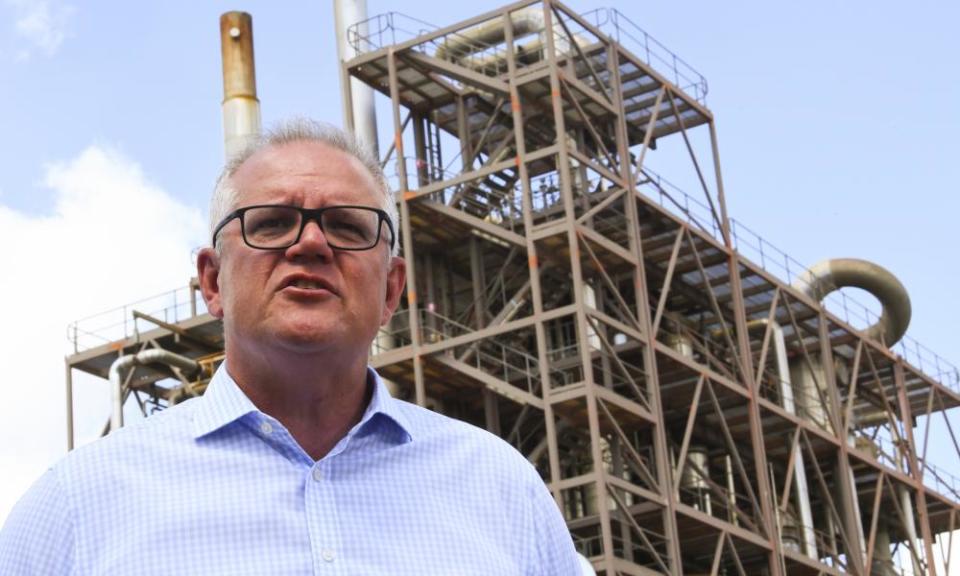Fall in unemployment raises likelihood Australian government will withdraw Covid support

Unemployment in Australia has fallen by 0.2% to 6.6%, a quicker than expected recovery that increases the likelihood economic supports will be withdrawn.
The addition of 50,000 jobs and 2m more hours worked in the month of December also drove the underemployment rate down to 8.5%, a further sign Australia’s economy has returned to growth despite the impact of the coronavirus.
After the release of the labour force statistics on Thursday, analysts suggested the Reserve Bank was likely to stop pumping money into the economy by buying government bonds and Scott Morrison warned that taxpayers’ money “can’t be used endlessly to run the Australian economy”.
Related: Don't read too much into the fall in Australia's payroll jobs, at least not yet | Greg Jericho
The Australian Bureau of Statistics found an extra 35,700 full-time and 14,300 part-time jobs were created in December, helping to drive down unemployment despite a 0.1% lift in the participation rate to 66.2%.
Nevertheless, over the year to December 2020 employment decreased by 0.5% or 63,900 people, indicating the economy had still not fully recovered from the impact of the coronavirus, including closure of international borders and widespread economic shutdowns in the first half of 2020.
Queensland led the recovery with a 1.4% increase in employment, followed by the Northern Territory (up 0.7%) and Victoria (0.4%), which emerged in November from its lockdown to combat the second coronavirus wave.
With the jobkeeper wage subsidy set to expire at the end of March, industries still hard hit by the coronavirus recession including tourism and hospitality have ramped up lobbying efforts for sector-specific relief packages.
The Tourism and Transport forum has released economic modelling claiming that the latest Covid-19 outbreaks and state border closures will reduce domestic tourism spending by $6.8bn from 24 December to 31 January.
The modelling by tourism economists Stafford Strategy warned if jobkeeper was not extended the tourism industry could lose 320,000 jobs by September 2021 due to the lack of international visitors and ongoing uncertainty over domestic borders.
Morrison told reporters in Gladstone “of course” the disruption of domestic tourism had “had that cost” and it was “fair and right” of the sector to draw attention to it.
But he warned the impact of a repeat of the Victorian second coronavirus wave “would have been far worse, so there are two sides to that coin”.
Morrison said the government had sought to provide “as much certainty as possible about what the support arrangements are” but businesses would have to make tough choices because it was “not sustainable” to continue to use debt to prop up the economy.
Asked if the government would introduce sector-specific support, Morrison replied: “At this stage the settings are as I’ve set them out and people should work on the basis of those settings unless they’re reviewed.”
Labor’s shadow treasurer, Jim Chalmers, said jobkeeper should be “tailored and responsive” to local economies to avoid “catastrophic consequences that many are predicting”.
In Cairns, he called on the government to devise a new turnover test to allow businesses that are still hard hit to continue to receive the wage subsidy – citing businesses in the tourism-dependent region that are still suffering revenue losses of 70%.
Earlier, Morrison told 4RO radio that critics had predicted big job losses after the rate of jobkeeper was reduced in September and December, but instead 450,000 businesses and 2m workers had graduated off the payments.
In addition to sector-specific support, the government was yet to decide whether to continue the coronavirus supplement on jobseeker unemployment benefits, permanently increase the jobseeker rate, or allow it to fall to $40 a day.
That rate is opposed by economists, the welfare sector and business groups – although some in the government argue higher rates could disincentivise work.
Related: Australian housing system ‘broken’ with more than half of low-income renters facing rental stress
In a statement, Capital Economics said the fact unemployment was now at its lowest rate since April 2020 meant the RBA was likely to end asset purchases in April 2021.
“Given that the RBA had expected the unemployment rate to rise to a new peak of 8% in [the fourth quarter] of 2020, the actual outturns clearly represent an upside surprise,” it said.
Capital predicted a further decline in unemployment because “job vacancies have continued to rise suggesting the labour demand from businesses remains high”.
The Australia Institute’s Matt Grudnoff warned that with “thousands of Australians being supported by jobkeeper in roles that may not continue beyond March, the headline unemployment rate doesn’t tell the whole story”.
The senior economist of the progressive thinktank cited the underutilisation rate of 15.1%.
“While a modest fall in unemployment is welcome, there is still a long way to go before we see a return to situation normal,” he said.

 Yahoo Finance
Yahoo Finance 